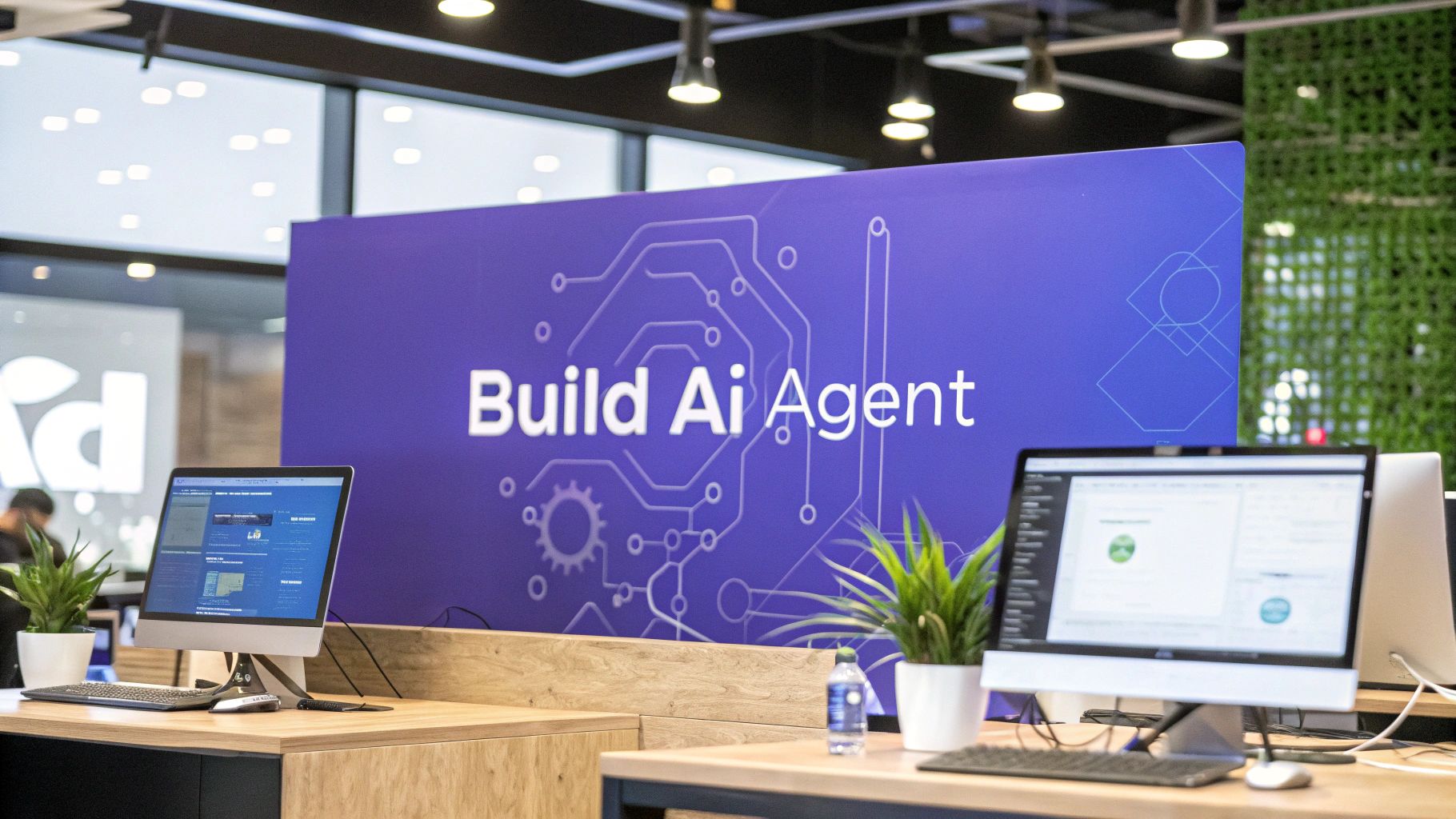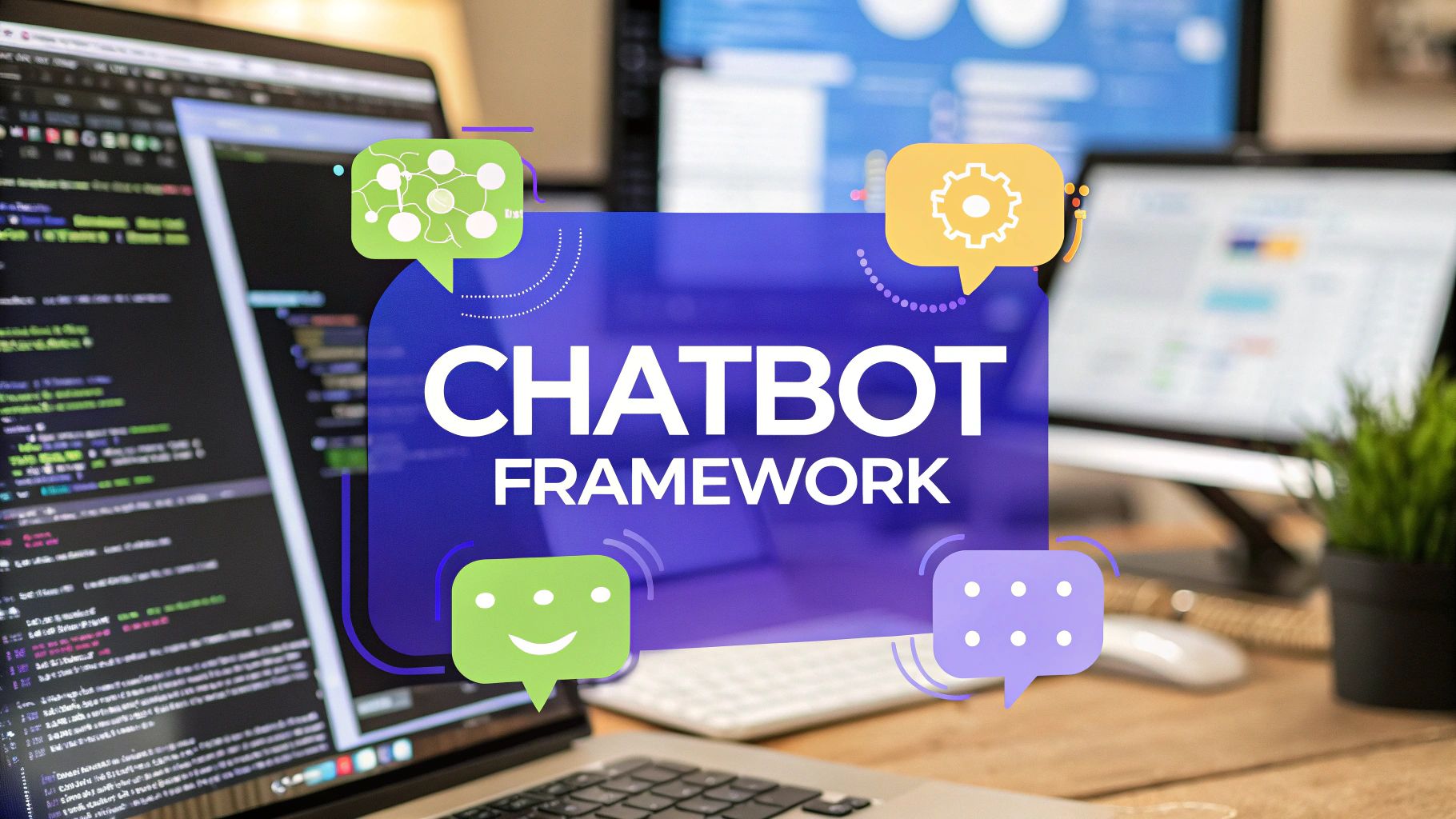Your Guide to the Modern Chat Bot API
Unlock conversational AI with this complete guide. Learn what a chat bot API is, how it works, and how to choose the right strategy for your business goals.
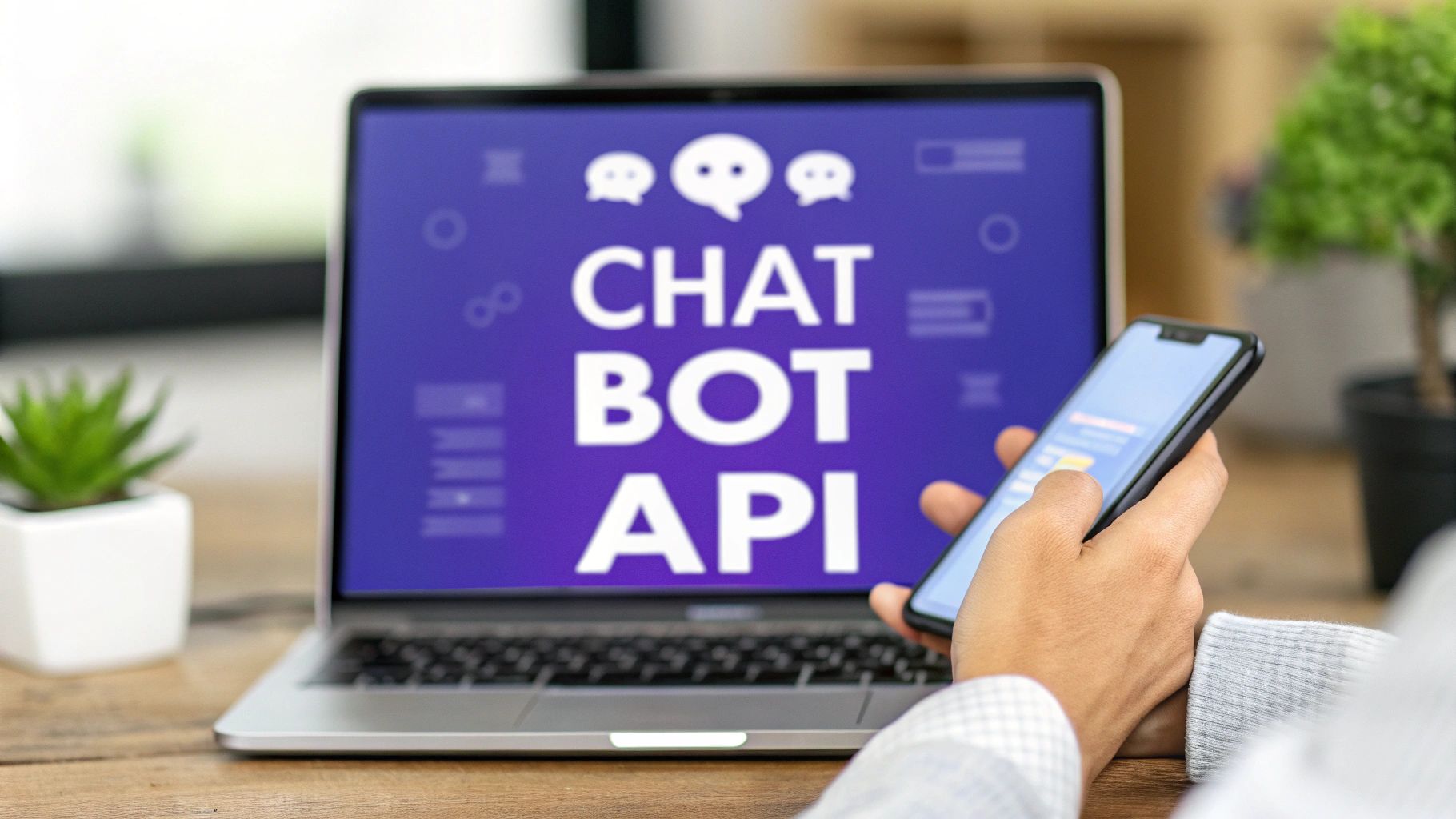
Let's be honest, the term "API" can make your eyes glaze over. But a chat bot API is actually a pretty simple concept when you break it down. It’s the technology that connects your app or website to a powerful, pre-built AI “brain,” so you can add a conversation without having to build that brain from scratch.
Think of it as the engine that powers the chatbot. It handles all the heavy lifting—like understanding what someone is asking and figuring out how to respond—completely behind the scenes.
What Is a Chat Bot API, Really?
Forget the technical jargon for a minute. Imagine you're at a busy restaurant. You (the customer) want to order a steak, and the kitchen (the AI model) is ready to cook it. But how does your order get from your table to the chefs, and how does the food get back to you?
You need a waiter.
In this scenario, the chat bot API is the waiter. It’s the go-between that listens to what you want (a user’s message), translates it into a language the kitchen understands (an API call), and brings back the finished dish (the AI-generated response). It manages the whole interaction so you don't have to think about it.
The Bridge to Advanced AI
Without an API, adding a chatbot to your website would mean building a massive Large Language Model (LLM) from the ground up. That’s a huge undertaking, demanding a ton of data, money, and specialized AI experts.
A chat bot API gives you a shortcut. It lets you "plug in" a pre-trained, ready-to-go conversational engine directly into your website, app, or even internal tools.
This connection lets your application send a user’s questions to a sophisticated AI service and get a smart, human-like response in seconds. The API handles all the hard work:
- Figuring out what users want: It deciphers the user’s true intent, even if they use slang, make typos, or phrase things awkwardly.
- Processing the request: It analyzes the question, gathers the right information, and puts together a relevant answer.
- Crafting a natural response: It creates a reply that sounds like a real person wrote it and sends it back to your app for the user to see.
Unlocking Real Business Value
This one piece of technology opens the door to some serious business value. By automating conversations and offering instant support, companies are seeing huge improvements in both customer happiness and how efficiently their teams work. The demand for this tech is exploding for a reason.
The global AI chatbot API market is growing like a weed, valued somewhere between $10–$15 billion in 2025 and expected to shoot up to nearly $47 billion by 2029. This boom shows just how much businesses are betting on smart, automated customer chats. You can find more data on this market trend and what's driving it.
At the end of the day, a chat bot API isn't just a technical tool; it’s a strategic move. It gives you the power to launch a digital assistant that can answer questions, complete tasks, and give your users a genuinely better experience—all without needing your own AI research lab.
How the API Powers a Conversation
To really get your head around how a chat bot API works, let's follow a single message from start to finish. It’s a lightning-fast journey that’s a lot like ordering a package online. The moment a user types "What are your business hours?" into a chat window, a whole sequence of events kicks off behind the scenes.
Think of that question as placing an online order. Your website or app immediately packages this message into an API request. This request is basically the shipping label for the order; it has everything the system needs to process it, including where it's going.
The Information Journey
The "destination" here is a specific endpoint—which is just a fancy term for the unique URL where the AI service "lives." Just like a courier needs the right warehouse address to pick up a package, your application needs the correct endpoint to send the request to the AI model. But before it gets there, security is front and center.
Before the AI service even peeks at the request, it needs to know who sent it. This is handled by an authentication key, a unique and secret code that travels with the request. It’s the digital equivalent of a secure login for an online store, proving you're a legitimate customer and not some random person trying to get in.
This visual shows how secure access is the first step in any API interaction, making sure only authorized applications can talk to the AI.
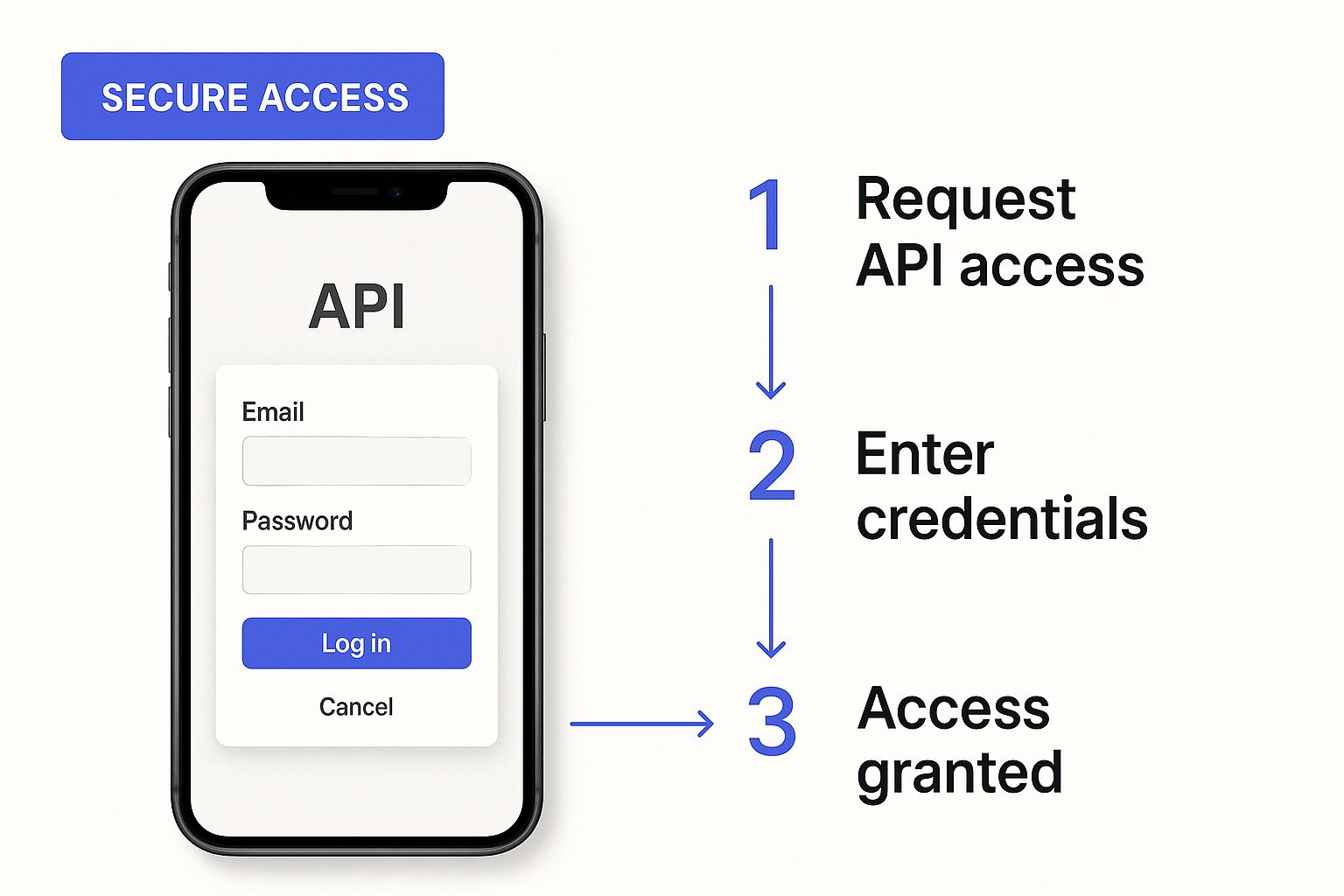
Without this key, the API simply rejects the request. It’s a critical step that protects both your system and the AI service from being used by anyone who shouldn’t be.
Once authenticated, the AI gets to work. It unpacks the user's message, which is typically formatted in JSON (JavaScript Object Notation). Don't let the name intimidate you; JSON is just a clean, lightweight way to organize data so machines can read it easily. Think of it like a warehouse using barcodes to instantly scan and understand what’s inside an order.
From Processing to Response
Next, the AI engine does its real magic: Natural Language Processing (NLP). It digs into the text to figure out the user’s intent—in this case, they want to know the business hours. This is like the warehouse staff finding the exact item you ordered on the shelves.
After finding the right information, the AI crafts a clear, helpful reply. It then packages this answer into an API response and sends it right back to your application. This is the final step, like the delivery truck pulling up to your door with the correct package.
Your application then simply displays this response in the chat window, and the user gets their answer. The entire back-and-forth happens in a fraction of a second.
What Can a Modern Chatbot API Actually Do?
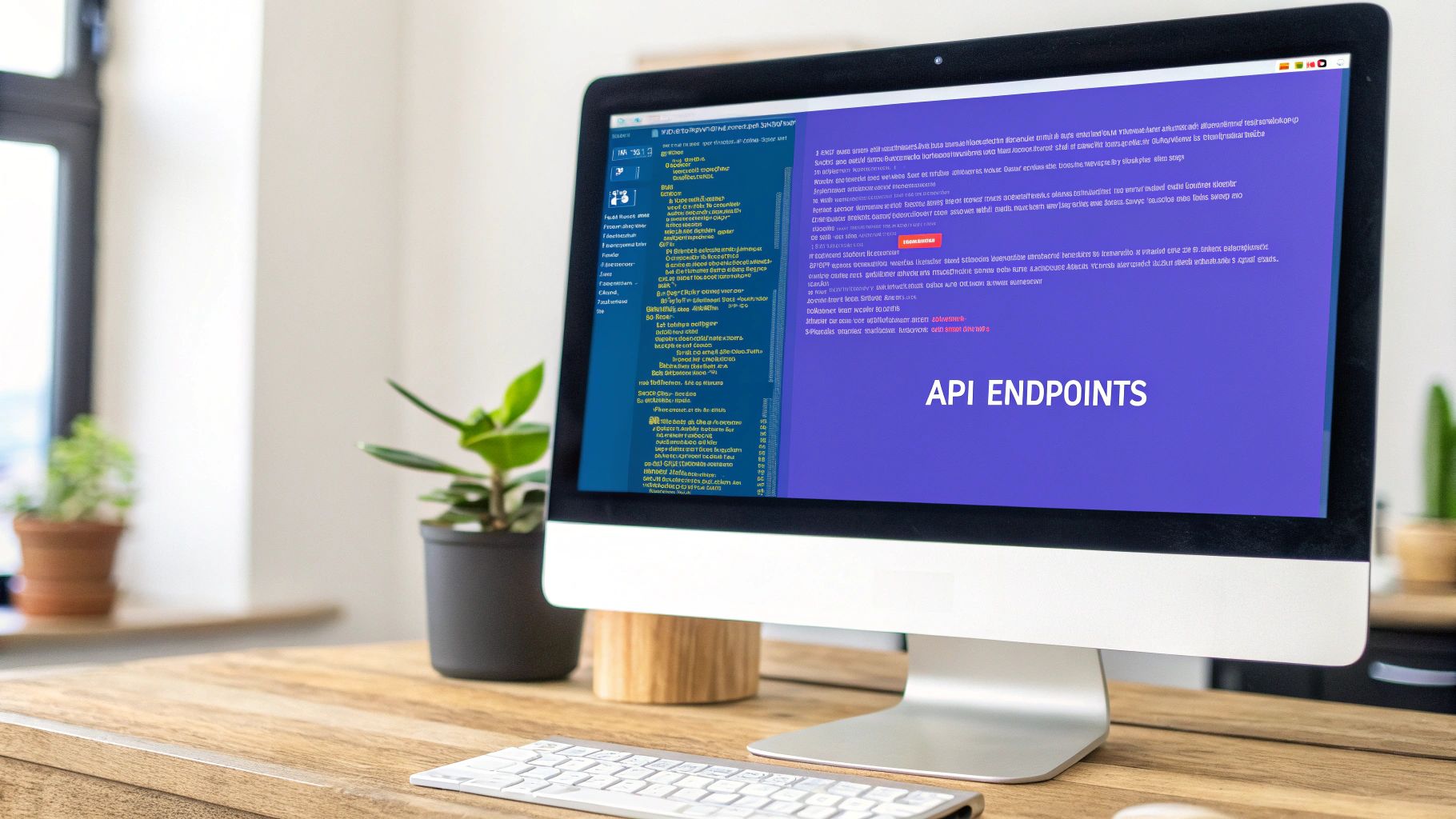
The best chatbot APIs are much more than just script-followers that spit out pre-written answers. They come packed with sophisticated features that allow them to understand, interpret, and respond to human language with surprising nuance.
These capabilities are what separate a clunky, frustrating bot from a digital assistant that’s genuinely helpful.
At the heart of this intelligence is Natural Language Understanding (NLU). Think of NLU as the bot’s brain. It’s what helps it grasp the intent behind a user’s words, even when they’re phrased informally or full of typos.
For example, a user might type "need flight to NYC next tues" instead of the more formal "I would like to book a flight to New York City for next Tuesday." A bot with solid NLU understands that both requests mean the exact same thing.
Another core feature is entity recognition, which is like a data extractor for conversations. It pinpoints and pulls out specific pieces of information—the "entities"—from messy, unstructured text.
Imagine an airline bot. Entity recognition is what allows it to grab the key details from a casual sentence. From "I need a flight to Boston for 2 people on June 15th," the API can instantly identify:
- Destination: Boston
- Party Size: 2 people
- Travel Date: June 15th
This is critical for any task-oriented chatbot, whether it's booking appointments, tracking packages, or processing orders. It turns a jumbled human request into structured data the system can actually use.
A good chatbot API provides a suite of these functionalities, each contributing to a more effective and human-like interaction.
Core Features of a Modern Chat Bot API
Here’s a breakdown of the essential features you'll find in today's leading chatbot APIs and the direct business impact they have.
These capabilities all work together. They transform a basic chatbot from a simple Q&A machine into a powerful tool that understands meaning, extracts data, and senses emotion.
Going Beyond Just Words
But modern APIs can do more than just understand intent and data; they can also interpret emotion. Sentiment analysis is the technology that gauges the user's emotional tone. Are they happy? Frustrated? Neutral?
This allows the bot to adapt its responses. If a customer is clearly frustrated, the bot can escalate the issue to a human agent or switch to a more empathetic tone. This emotional intelligence is key to managing customer relationships. In fact, research shows that 73% of customers fall in love with a brand because of friendly customer service, and sentiment analysis helps bots contribute to that.
These core capabilities—NLU, entity recognition, and sentiment analysis—are what make a modern chat bot API a powerful conversational tool. The API doesn't just process words; it understands meaning, extracts data, and senses emotion to create a much more effective and human-like interaction.
If you’re looking for a deeper technical dive, you can explore more on how to use an api for a chatbot and integrate these powerful features.
Choosing Your Strategy: Build vs. Buy

When you decide to bring conversational AI into your world, you’ll hit a fork in the road right away. Do you build a custom chatbot API from scratch, or do you license a ready-made solution from a third-party provider?
This isn’t a small choice. It shapes everything that follows—your budget, your timeline, and the final experience you deliver to users. Each path has its own set of compelling pros and very real trade-offs.
Think of it like getting a house. Building a custom home gives you complete freedom over the blueprint, the materials, and every last detail. Buying an existing home is faster and simpler, with far more predictable costs.
The Case for Building Your Own API
Building your own chatbot API is the path of ultimate control. You aren’t boxed in by a vendor’s feature list or their development roadmap. Instead, you can craft a system that’s perfectly molded to your unique business logic, data models, and security needs.
This approach lets you create deep, native integrations with your proprietary systems. The result is a seamless flow of information that most off-the-shelf APIs would struggle to match. You own the IP, and you call all the shots on how the technology evolves.
But make no mistake, this path is demanding. It requires a serious upfront investment in:
- Talent: You’ll need a skilled team of developers, data scientists, and AI specialists who know what they're doing.
- Time: Building, testing, and deploying a robust API can easily take months, if not years.
- Infrastructure: The cost and complexity of setting up and maintaining the necessary servers and data pipelines are significant.
For companies with highly specialized requirements, strict data sovereignty rules, or the ambition to build a core competitive advantage, the "build" strategy is often the right long-term play. For a detailed look at what's involved, our guide on how to build a chatbot breaks down the entire process.
The Case for Buying a Third-Party API
The "buy" route—licensing an existing chatbot API from a specialized provider—is by far the more common and accessible choice for most businesses. It offers a powerful blend of speed and sophistication.
The biggest win here is speed to market. You can plug a powerful, enterprise-grade chatbot API into your app in a matter of days or weeks, not months or years. This means you start delivering value to your customers almost immediately.
These providers have already poured millions into R&D, giving you access to state-of-the-art AI without the massive R&D bill. You get the benefit of their ongoing improvements, security patches, and a predictable, subscription-based cost model.
Of course, there are things to consider. You're dependent on the provider's platform, which means less control over specific features or how they handle data. Those recurring subscription fees can also add up. It's crucial to find a reputable partner with solid data privacy policies and clear service-level agreements (SLAs) to keep the risks low.
So, which path is right for you? It really boils down to your specific situation. Take a hard look at your budget, in-house technical skills, timeline, and long-term goals to decide whether building or buying a chatbot API is the best fit for your organization.
How Industries Are Using Chat Bot APIs
The true power of a chat bot API snaps into focus when you see it solving real-world problems. While most people picture chatbots answering basic customer service questions, their real impact goes much deeper, especially in specialized industries. They’re quickly becoming essential tools for automating complex, high-value tasks.
This isn't some far-off future tech; it's already deeply integrated across major sectors. The results are impressive. AI chatbots can handle up to 80% of routine customer questions without needing a human to step in. For some companies, this automation has led to annual savings of around $300,000 and contributes to a global reduction of roughly 2.5 billion labor hours. You can discover more stats on AI chatbot adoption to see how fields like real estate, finance, and healthcare are putting them to work.
Boosting Efficiency in Real Estate
In real estate, timing and responsiveness are everything. A chat bot API can be plugged into a brokerage’s website to act as a 24/7 lead qualification machine. When a potential buyer lands on a listing, the bot can instantly answer their questions about square footage, price, and amenities.
But here’s where it gets smart. The bot can also ask key qualifying questions:
- "Are you pre-approved for a mortgage?"
- "What’s your ideal move-in date?"
- "Would you like to schedule a viewing for this weekend?"
Based on the answers, the bot can automatically book a viewing on an agent’s calendar or flag the lead as high-priority in the company’s CRM. This frees up agents from those repetitive, initial conversations, letting them focus their energy on closing deals with genuinely interested buyers.
Enhancing Patient Care in Healthcare
The healthcare industry is using chat bot APIs to improve how they connect with patients and streamline endless administrative work. Imagine a patient finishing a virtual consultation. A chatbot, connected to the clinic's system via an API, can immediately start a follow-up conversation.
A healthcare bot can ask, "Would you like me to schedule your follow-up appointment for two weeks from now?" or "Shall I send a prescription renewal request to your pharmacy?" This automates routine tasks, cuts down on administrative overhead, and gives patients a seamless, convenient experience.
These bots also send out automated medication reminders, answer common questions about post-procedure care, and help patients find their way through confusing insurance queries. That level of instant, personalized support helps improve patient outcomes and builds lasting loyalty.
Securing Transactions in Finance
For banks and financial institutions, security and instant communication are non-negotiable. A banking chat bot API can provide real-time fraud alerts that are both immediate and interactive. If the system flags a suspicious transaction, the API triggers the bot to message the customer right away: "We've detected a purchase of $500 at a new merchant. Was this you?"
The customer can confirm or deny it with a simple "Yes" or "No." If they reply "No," the bot can instantly freeze the card and escalate the issue to a human fraud specialist. This immediate interaction drastically shrinks the window for criminals to do damage and gives customers incredible peace of mind.
The same bot can also handle balance inquiries, process transfer requests, and answer questions about different loan products, all with the same speed and security.
Common Questions About Chat Bot APIs
As you start exploring what a chat bot API can do, it's totally normal for questions to bubble up. This tech is a fascinating mix of conversational AI and behind-the-scenes systems, and getting a handle on the practical details is the first step to moving forward with confidence. We’ve tackled some of the most common questions to give you clear, straightforward answers.
What Is the Main Difference Between a Chatbot and a Chat Bot API?
It helps to think of it like a car. The chatbot is the car itself—the part you actually see and interact with. It's the steering wheel, the seats, the dashboard. It’s what the user experiences.
The chat bot API, on the other hand, is the powerful engine under the hood. It’s the complex machinery that provides the intelligence, processing what you say, finding the right answers, and making the whole thing go. You can build all sorts of different car models (chatbots) using the same high-performance engine (API).
How Much Does It Cost to Use a Chat Bot API?
The cost can swing wildly depending on what you need. For third-party APIs, most providers work on a pay-as-you-go model. Your fees are usually based on how many API calls you make or the amount of data you process. A simple bot with low traffic might only cost a small amount each month.
But a complex, high-volume bot for a big company could easily run into thousands of dollars. If you’re building a completely custom solution from scratch, that’s a major investment. Simple bots can be developed for as little as $5,000, but a really sophisticated system can cost upwards of $500,000. The key is to analyze the pricing models and get a realistic estimate of your usage to budget effectively.
Do I Need to Be a Developer to Use a Chat Bot API?
Not anymore. While building a fully custom integration still requires a developer's touch, the rise of no-code and low-code platforms has opened the doors for everyone. These platforms basically act as a user-friendly layer on top of a powerful chat bot API.
They give you visual, drag-and-drop interfaces that do all the heavy lifting with the API connections behind the scenes. This empowers business users, marketers, and support teams to design and launch impressive conversational experiences without having to write a single line of code.
How Should I Manage Data Privacy with a Third-Party API?
This is a huge responsibility, and you have to get it right. When you use a third-party API, you're trusting that provider with your users' data. It's absolutely essential to partner with a reputable company that has a strong, transparent privacy policy and complies with regulations like GDPR and CCPA.
Always read a provider's terms on data ownership, storage, and usage. The best vendors offer data processing agreements (DPAs) and give you the choice to prevent your data from being used to train their models. This is how you maintain control over sensitive information.
For businesses in fields like healthcare or finance that handle highly sensitive data, an on-premise solution or a provider with dedicated private models is probably a better fit. It ensures maximum security. For more detailed guidance, it's important to follow established chatbot best practices to protect both your company and your users.
Ready to build an intelligent assistant trained on your own data? With Chatiant, you can easily create custom AI agents and chatbots that integrate seamlessly with your website, Google Chat, or Slack. Empower your sales, operations, and support teams by connecting AI to your business data and automating key actions. Start building your advanced chatbot today with Chatiant.
